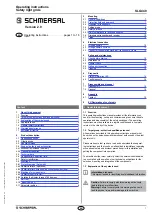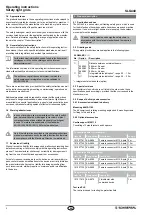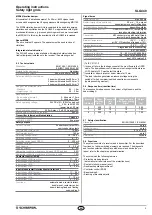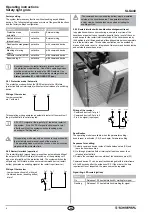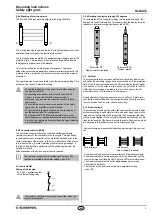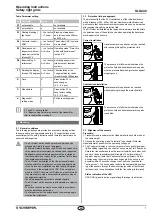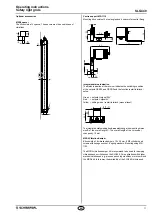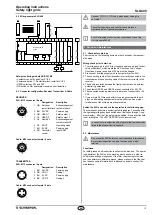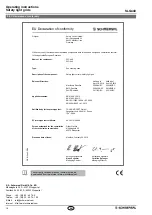
7
SLG440
Operating instructions
Safety light grids
EN
Table Parameter setting
No. Parameter
Status
Note
P 1
not available
n
not available
P 2
not available
n
not available
P 3
Floating blanking 1
light beam
– = not active
1 = 1 beam
Blanking of
one
beam,
only for resolution 300 mm
and 400 mm
P 4
Contactor control/
EDM
– = not active
A = Active
The auxiliary (NC) contacts
are monitored
P 5
Double acknow-
ledgement with com-
mand device restart
interlock N° 2
– = not active
A = Active
Operating mode "Protective
mode with double reset"
restart n° 2"
P 6
Beam coding A
(alternative)
– = not active
A = Active
Activating upon mutual
interference of identical
systems
P 7
Rotating the display
through 180 degrees
– = not active
A = Active
The orientation of the
7 segment display can be
turned through 180 degrees
S.
Save
S
Press button S1 to
save changes
(25 …60 sec)
C.
Clear/delete
C
Press button S1 to
save factory setting
(25 …60 sec)
d.
Diagnostic/
setting mode
d
Switch to setting mode
P 1 and P 2 - not available!
P 6 - Beam coding A must also be set at the transmitter,
refer to chapter Beam coding A
3. Mounting
3.1 General conditions
The following guidelines are provided as preventive warning notices
to ensure a safe and appropriate handling These guidelines are an
essential part of the safety instructions and therefore must always be
observed and respected
•
The SLG must not be used on machines, which can be
stopped electrically in case of emergency
•
The safety distance between the SLG and a hazardous ma-
chine movement must always be observed and respected
•
Additional mechanical safety guards must be installed so
that the operator has to pass by the protection field to reach
the hazardous machine parts
•
The SLG must be installed so that the personnel always
must be within the detection zone when operating the ma-
chine An incorrect installation can lead to serious injuries
•
Never connect the outputs to +24VDC If the outputs are
wired to +24VDC, they are in ON state, as a result of which
they are unable to stop a hazardous situation occurring on
the application/machine
•
The safety inspections must be conducted regularly
•
The SLG must not be exposed to inflammable or explosive
gasses
•
The connecting cables must be connected in accordance
with the installation instructions
•
The fixing screws of the end caps and the mounting angle
must be firmly tightened
3.2 Protection field and approach
The protection field of the SLG consists only of the individual beams
with a distance of 300, 400 or 500 mm Additional protective devices
must ensure that hazardous machine components can only be reached
after passing through the protection field
The SLG must be installed so that personnel are always located within
the detection zone of the safety device when operating the hazardous
machine parts to be secure
Correct installation
Hazardous machine parts can only be reached
after passing through the protection field
The presence of staff members between the
protection field and hazardous machine parts
must be prevented/avoided (protection against
stepping over)
Unauthorised installation
Hazardous machine parts can be reached
without passing through the protection field
The presence of staff members between the
protection field and hazardous machine parts
is enabled
3.3 Alignment of the sensors
Procedure:
1 Transmitter and receiver must be fitted parallel to each other and at
the same height
2 Choose the operating mode "Automatic" (see chapter Protective
mode/automatic) and switch the operating voltage on
3 The 7-segment display in the receiver shows the current signal qual-
ity/fine setting (signalling, see chapter "set-up mode") for 30 seconds
Rotate the transmitter and then the receiver towards each other until
you have the best possible signal strength of 3 horizontal bars (7
segment display) (note that 2 horizontal bars is sufficient) Fix this
position using the screws to the mounting angleIf the set-up is not
possible within 30 seconds, change to set-up mode (see chapter
"set-up mode") The set-up mode leads to the best possible position-
ing of the sensors through the basic setting (position of the first and
last beam) and the optimisation of with the fine setting (total signal)
Status indication of the LED
OSSD ON (green) is active, signal strength (orange) is not active

